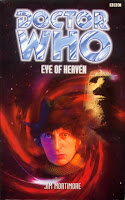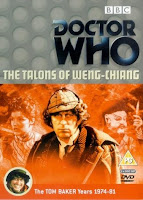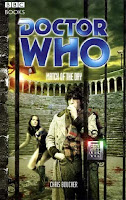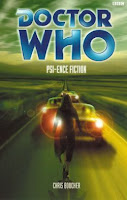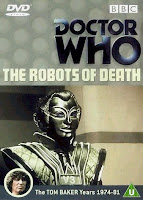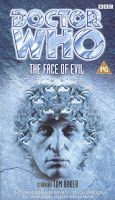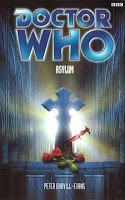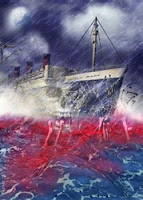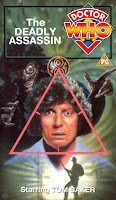
En route back to Gallifrey, the Doctor is troubled by a vision of the assassination of the President of the High Council of the Time Lords. When he arrives on his home planet in an effort to stop it, he is immediately treated as a criminal due to his past trial and when the assassination goes through he is arrested for it. The Doctor realizes that he has been set up to take the fall for it, and someone has gone to extraordinary lengths to drag him into the conspiracy, including breaking into the Time Lords' ultimate databank, the Matrix, and creating a nightmare world where the Doctor must go to flush out the true killer. The Doctor has his suspicions about who is involved, but the presence of miniaturized corpses throughout Gallifrey confirms it: the Master is back. Deformed and dying, the Master is after the source of all the Time Lords' power in an attempt to revitalize himself, and if he succeeds in capturing the Eye of Harmony, not only will Gallifrey fall, but countless other worlds.
So we're back to the Doctor's home planet for only the second time in the show's history, and we see it as a sterile world inhabited by stuffy old men (no women at this point; their sole function in this adventure is to be computer voices and that's pretty much it) in ceremonial robes and elaborate high collars of office. Gallifrey is not a planet accustomed to violence, which is why the Time Lords were so replused by the Doctor's adventures in the first place, so when it strikes from within the safe society itself, fear is everywhere. Confusion is next. And the Doctor is at the middle of it, but this time on his own with no companions to help him out and one of his deadliest enemies working to destroy him.
The Master is not the same Master we watched during the Jon Pertwee era; as Roger Delgado had passed away during the last of the Pertwee days, there was a sense of reverence about the role and no-one wanted to throw a replacement in right away, and when they finally did there was no attempt to cast a lookalike. The Master here is skeletal and horribly deformed, his face melted away so he has no eyelids, and veins riddle the surface of his skin. He almost looks like he would be sticky to touch. But while the body rots, the mind within is kept alive by fanning the fires of hatred for the Doctor.
The Deadly Assassin has two of the best cliffhangers in the entire series; at the end of part 2 the Doctor's foot is caught in a railway switch while a train comes rocketing down the tracks towards him, and at the end of part three, we see the one sequence that has plagued Mary Whitehouse since its original broadcast: the imagine of the Doctor being held underwater and drowned by his assailant within the Matrix. The entire sequence of events within the Matrix is fantastically done with no real special effects, just extensive location work with the Doctor being hunted by a masked man with a gun and survival gear. Brilliant. And as with dreams themselves, the time that passes within the Matrix feels longer than it is in "real" time, with Time Lords Spandrell and Engin watching over the Doctor while he is within and commenting that he had been inside for over four minutes, while the time passed on screen was much longer than that.
More Time Lord mythology is brought up, this time throwing some light on the history of Gallifrey and on Rassilon, the first of the Time Lords. All of Gallifrey's power is derived from the Eye of Harmony, which is the nucleus of a black hole balanced perfectly against the mass of Gallifrey itself, a gift which Rassilon bestowed upon the Time Lords, so the official history states. Gallifreyan truth, however, is revealed to be a very flexible commodity as the Doctor's old teacher, Cardinal Borusa, demonstrates in his efforts to prepare a cover story for the public to explain the events that unfold. And anyone who remembers The Three Doctors knows that Omega created the power source for Gallifrey by journeying into a black hole, but he ended up stuck there while Rassilon finished his work and took the glory. The Time Lords have also conveniently forgotten the Master despite personally warning the Doctor of his presence on Earth back in Terror of the Autons and later realizing that he had stolen the plans to the doomsday weapon in Colony in Space. Gallifrey, it seems, is not the paradise of peace and truth that the Time Lords would have everyone believe.
And how does the Doctor do without a companion? In this story it makes sense for the Doctor to perform on his own; there would be little for a companion to do except shadow the Doctor and ask questions. This is not to condemn recently departed companion Sarah Jane Smith at all, but even she would be out of place on Gallifrey, and what's more she would be obvious. It does get a bit awkward though when the Doctor talks to himself as a means of filling in the audience where dialogue with a companion was once the way it was done, but it happens very seldom. Tom Baker himself preferred the idea of the Doctor travelling alone without a companion, but the series formula would not allow it and in the next adventure he would take on a new companion, which he would take issue with.
However, before carrying on with the televised series, I'll look at some books that give Tom Baker exactly what he would have wanted; the Doctor on his own, adventuring and exploring just as he did in the days before his trial, but on his own this time...
NEXT EPISODE : GHOST SHIP
Labels: Gallifrey, The 4th Doctor, The Master

